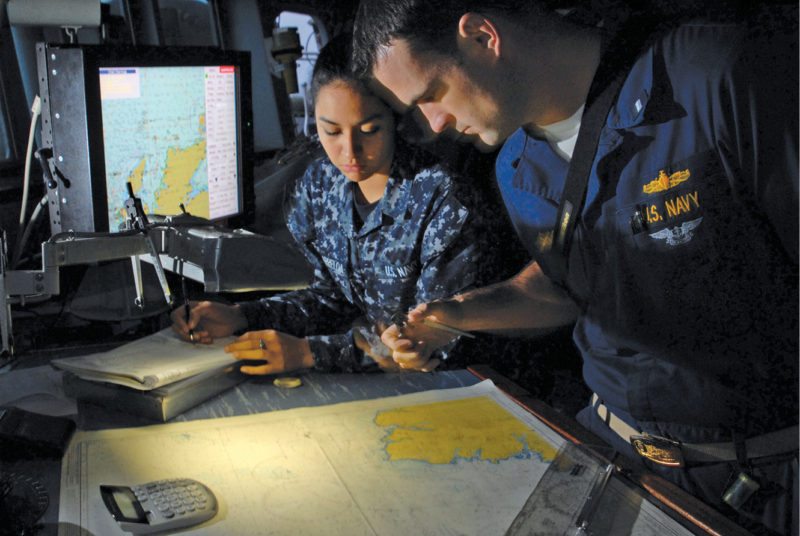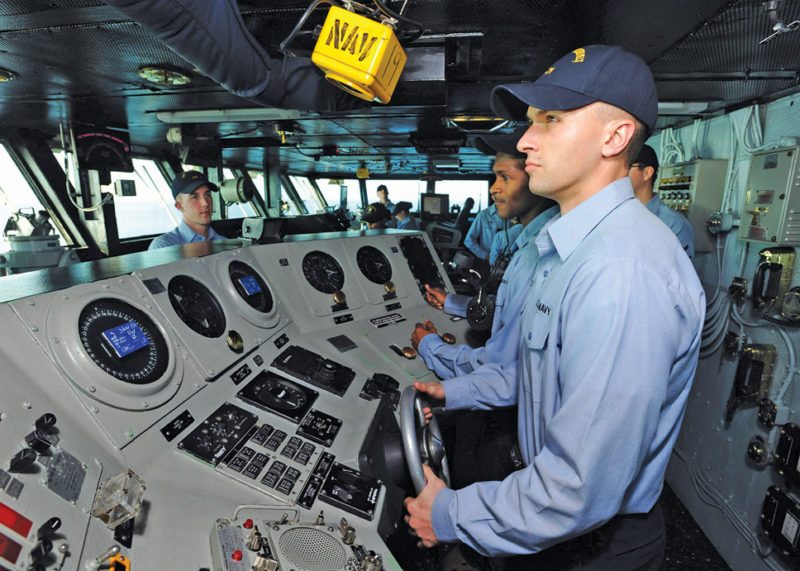Similarly, there are commanders for underwater warfare, surface warfare, EW and strike warfare. The CSG commander can also exchange targeting information and engagement orders, not only within his or her CSG but also with other CSGs.
Cruise control operations
Cruise control operations involve navigation and propulsion operations. They are carried out in a similar way as commercial shipping navigation.
Navigation. Navigation was done through compass in the olden days; then emerged sextants and printed navigation charts. These printed navigation charts are like a detailed map but for sea routes, and indicate depth of a certain area in the sea, width of straits and other information. Now, these charts are the tools of the past and are only used as a fallback option today. Their roles have been taken over by a system called electronic chart display and information system (ECDIS), which takes inputs from electronic navigation charts (ENCs) and displays the area of interest.
These ENCs have complete hydro-graphical information like navigational hazards, depth of a particular place, width of the navigable channel and a lot more, as electronic data.
GPS is used to find out the precise position of the carrier and other ships. This positional information is fed to the ECDIS, which displays all relevant data so that the navigator gets the complete idea of his or her position and surroundings.
Radar AN/SPN-67, which is also used in a ship self-defence system (SSDS) is used for navigation. Along with this radar, a radar called AN/SPS-64 is also used for navigation. This radar operates on a fixed frequency of 9GHz and has a peak power output of 20kW. Its antenna can rotate at speeds up to 33rpm, which provides a high degree of target resolution and also allows target information update for every two seconds.
After detecting contacts through this radar, a system called automatic identification system (AIS) helps in identifying the nature of the contact. AIS is a system that all sea-going non-military vessels must possess. It relays its identification in radio frequency (like identify friend or foe, or IFF).


Generally, the required instructions for navigation are given by the captain from the combat direction centre (CDC). Necessary information like a copy of navigation radar displays is available at the bridge, which is the command centre for sailing the carrier. This bridge is the first storey above the flight deck. From here, sailors called helmsmen, control the sailing operations. Aegis escorts also have similar navigation radars and helmsmen controls.
Propulsion. The next part of Cruise control operation is Propulsion. A carrier’s propulsion power comes from the electricity generated from two scaled-down nuclear reactors. These produce a shaft horsepower of 140MW to drive propeller shafts. Electronic systems that are used in controlling the nuclear chain reaction and associated functions of normal reactors are also found in the carriers.
These reactors can work continuously for 20 years without requiring any refuelling. With the aid of these reactors, carriers can reach speeds of 55kmph with ease. In naval parlance, sailing at this speed is like driving a Formula One car, and almost 100 thousand tonnes of mass sailing at this speed is something unimaginable.
Other vessels of the CSG are not nuclear powered but are powered by diesel-fuelled gas turbine engines. Controls of these propulsion systems also resemble industrial-class designs with military standard.
Thus cruise control operation is carried out.
Russian carriers: The other side of the coin
Definitely, American CSGs are a force to reckon with. But one cannot forget Prince Hector or Karna while speaking about Achilles and Arjuna, respectively. So, such a detailed literature on American carriers will not be complete without mentioning the Russian carrier force.
Traditionally, Soviet Navy’s and later Russian Navy’s speciality is that these are a submarine dominant forces. Though there are very much capable surface vessels in their navies, dominance of their submarines is greater. As water is the best antidote for fire, submarines are a perfect match capable of standing toe to toe with the CSG. But it did not restrict Soviet Union to try its part on carriers.
Basically, pioneers in naval technology are Britons. British Empire sustained with the strength of their navy. World’s first carrier, HMS Argus, was a British ship. Many of the novel naval innovations are theirs, such as radars and sonars. After the 1970s, the UK restricted itself to small carriers with aircraft, known as Harrier, capable to take off vertically.
Britons installed a ramp called ski jump at the edge of the carrier. Harriers run through this ramp to get air-borne. Indian Navy is also operating such a carrier called INS Viraat and a handful of Harriers.










